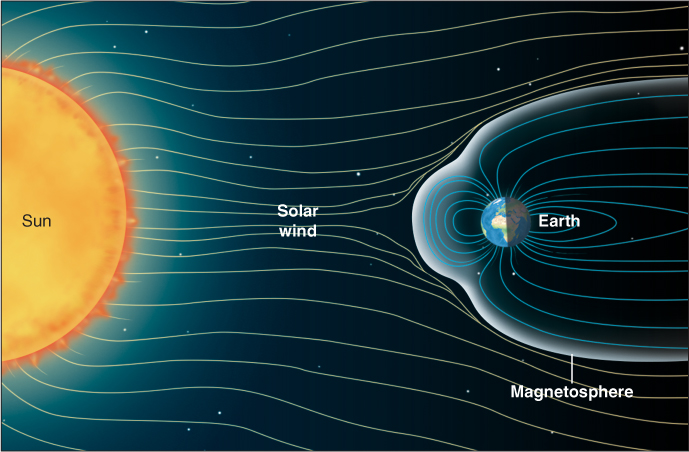11.4 Earth’s Heat and the Biosphere

Assess the connection between Earth’s internal heat and life on Earth.
What effect does Earth’s internal heat have on the biosphere? What would happen if Earth’s interior cooled? We cannot cool down Earth’s interior to see what happens. We can, however, learn from other planets.
Lessons from Mars
Today, Mars is barren, bitter cold, and devoid of life, as far as we can tell. There is water on Mars, but it is permanently frozen at both poles and hidden deep within the Martian soils. The average temperature at midlatitudes is about −45°C (−50°F). Atmospheric pressure is only a hundredth of Earth’s, so low that humans could not survive for a full minute without a pressurized suit. In fact, in terms of atmospheric pressure and temperature, a typical day on Mars might be similar to a typical day 120 km (75 mi) or so above Earth’s surface—
Earth stands in sharp contrast to Mars. Whereas Mars appears reddish-

What caused Earth and Mars to take such very different paths early in the history of the solar system? Why did Mars lose its water and atmosphere, even as Earth’s were retained? The answer lies just below our feet.
The Outer Core and Life
Our tour of the internal Earth in this chapter revealed the layered structure of the planet. We have seen that the outer core is made predominantly of iron and nickel, and that it generates a magnetic field as it circulates deep within Earth’s interior. And we have seen that Earth’s magnetic field forms a shell-
magnetosphere
The outer edge of the magnetic field that surrounds Earth and shields it from the solar wind.

Sudden increases in the solar wind create problems for people on Earth, including cancer, communications problems with satellites and cell phones, and drought. Because of the solar wind’s damaging effects on organisms, terrestrial life probably would not be possible without the magnetic field. Life would reside only within the protective water of the oceans.
The magnetic field plays another important role in making Earth a habitable planet. Scientists know that Mars once had oceans and a thicker atmosphere. They also know that Mars once had a stronger magnetic field than it does today. Evidence for this conclusion lies in rocks found on Mars and on Earth that have become magnetized as they cooled directly from molten lava. Satellites with magnetometers (instruments that detect magnetism) orbiting Mars can detect this magnetism in surface rocks. On Earth, new rocks still become magnetized today. On Mars, only rocks several billion years old or older are magnetized; newer rocks are not. Several billion years ago, the rocks on Mars stopped becoming magnetized as they cooled.
For whatever reason, and scientists are not sure why, the strength of the Martian magnetic field diminished several billion years ago. One possibility is that the interior of Mars cooled enough that its liquid metal core stopped circulating and creating a magnetic field. Another possibility is that Mars was hit by a series of very large asteroids, which heated the surface, disrupting the core’s ability to generate a magnetic field. Once the magnetic field of Mars was weakened, the atmosphere would have been exposed to the solar wind. Many scientists think that Mars’s atmosphere and oceans were stripped away by the charged particles of the solar wind, leaving the planet the cold and sterile place it is today.
If Earth lost its magnetic field, its atmosphere and oceans would also be stripped away by the solar wind. Instead, Earth’s internal heat generates the magnetic field that prevents this from happening.
Tectonism, Oceans, and Climate
Earth’s internal heat also plays a critical role in moderating the chemistry of Earth’s atmosphere through tectonism. As we have seen in this chapter, convection and flow in the lower mantle and the asthenosphere result in movement of the overlying lithospheric plates. And as the plates move, they create volcanic activity (as we will see in Section 12.3).
Volcanoes were instrumental in creating and modifying Earth’s early atmosphere and oceans, and they continue to modify those physical systems today. In Section 2.5, we saw that carbon dioxide is an important greenhouse gas that modifies the average temperature of the atmosphere. As part of the long-
This does not happen because carbon-
Earth’s internal heat generates the magnetic field that shields life from the harmful solar wind. It also drives the movement of the lithospheric plates and creates volcanoes. These phenomena provided water to create the oceans, and they modify Earth’s atmosphere and make it suitable for life. The planet’s internal heat is an essential part of its life-